|
Modeling > Result
After ODE and Parameters, it's time to see the simulation result.
The Goal of Simulation
Of course, the ultimate goal of modeling is to simulate the circuit as accurate as possible. However, due to the complexity of biological system and very little we have known about it, it's almost impossible to simulate exactly. Thus, we come up a series of standards, which will be the main goals of our modeling. Here're the standards:
- The Biological System Should Follow the Truth Table
As we mentioned in project section, the dog (and of course the model) should react in a specific way under certain circumstances, which has been concluded into a truth table. To simulate perfectly, our model should follow the truth table, which is the primary goal without doubt.
| NO MEMORY
| WITH MEMORY
|
| FOOD
| BELL
| OUTPUT
| FOOD
| BELL
| OUTPUT
|
| 0
| 0
| 0
| 0
| 0
| 0
|
| 1
| 0
| 1
| 1
| 0
| 1
|
| 0
| 1
| 0
| 0
| 1
| 1
|
| 1
| 1
| 1
| 1
| 1
| 1
|
- The Result Should Fit A Dog's Reaction
OK, what we do this year is to simulate Pavlov's dog. Thus, our modeling should not only concentrate on biological mechanism, but also follow a dog's reaction towards certain things. Here're some circumstance we've thought up. If you have new ideas, feel free to email us! Please email to c.z.tian AT gmail.com
GFP output should be stronger under a food stimulus
Food is a direct stimulus while bell is a more indirect one. Generally, under direct stimulus, the dog will react stronger.
If the dog has memory and is given a bell stimulus, GFP output should have a delay
The dog takes time to link BELL with FOOD :]
- The Value for Each Parameter Should NOT Be Too Extreme
This is also an attemp to simulate the system as accurately as possible.
Now, let's see the result!
Result - T3 RNA Polymerase
Here we'll demonstrate dynamics of GFP(output,shows how strongly the dog reacts), CI and CI434(bistable switch, represents the memory). In the figures below, CI was represented by pink line, CI434 was represented by blue line while yellow line shows the dynamics of GFP output. Since no input, no output. We'll skip the No food+No bell situation.
| Situations
| Simulation Result | Remarks and Explanations
|
| No Memory | Food | 
| We give the dog a food stimulus at 250 min, and we can see there's a large GFP peak, which means the dog reacts to the food. Since there's no training, the memory state(CI, CI434) doesn't change
|
| | Bell
| 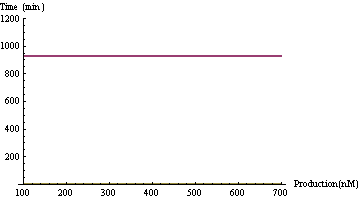
| We only give the dog a bell stimulus at 250 min. The memory state is not affected by this process, and we can't see any dynamics of GFP in this figure.
|
| | | 
| However, if we zoom in, there's a small GFP peak, which we regard as no output.
|
| | Food+Bell | 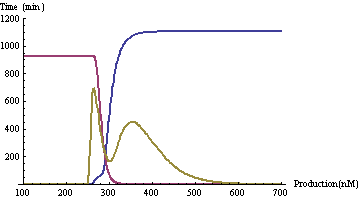
| At 250 min, both food stimulus and bell stimulus are presented. The dog reacts strongly. From the simulation result, we can conclude these facts:
1. There're two GFP peak. Firstly, it means the dog has successfully reacted to the stimuli, which accords to the truth table. However, you may wonder why there're two peaks. That's because there're two procedures which can lead to GFP output. The first one is the food(Sal) directly interacted with the OR Gate and Output module, which causes GFP production. Meanwhile, since both stimuli present, the signals pass through AND Gate 1 module and turn the bistable from CI434 state to CI state, which means the dog starts to remember the relationship between the two stimuli. As a result of that, the mRNA production of T3 increases, as you may mention that the promoters of T3 and CI are exactly same. Since Aa-tRNA(production activated by bell stimulus) still exists, the signals of T3 mRNA and Aa-tRNA pass through AND Gate 2 and finally, the OR Gate and Output module. Since there're a lot of reactions involved, you can see there's a time delay of approx. 100 min.
Now some fun:] Let's mimic a situation. We train the dog, and dog initially drools because of the food. However, after several minutes, the dog thinks, why there was a bell ring? Maybe it's because it means the food comes! The dog thinks of food by then, and drools.
2. The concentration of CI increases while the concentration of CI434 decreases. This phenomenon indicates that the dog has remembered the relationship between food and bell.
|
| With Memory | Food | 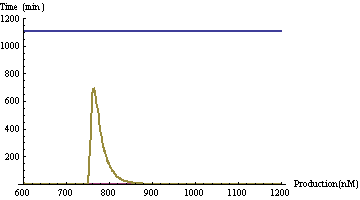
| Now the dog has memory. We give food stimulus at 750 min and the dog reacts similarly, just like the situation with no memory.
|
| | Bell | 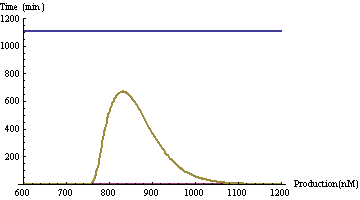
| Here's the big part. After the training, we give the dog a bell stimulus at 750 min. As we can see in the figure, CI is in high state. Since the promoters of T3 is exactly the same with these of CI, the transcription of T3 is also in high level. Then as the bell stimulus comes, the circuit generates large quantities of Aa-tRNA, which enable T3 to translate as the signals pass through AND Gate 2. For the result of these situation, we can see a very large GFP peak in the figure.
|
| | Food+Bell | 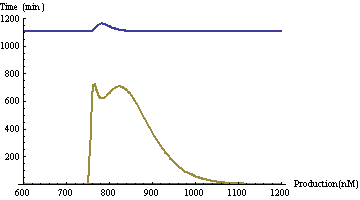
| If we give both stimuli, the output will be two GFP peaks. However, we may notice there's also a small peak of CI. From the view of non-linear dynamics, CI tries to escape the attractor to reach a higher level, which fails in the end. From a dog's point of view, the dog strengthens its memory after the second training for a short while. After that, its memory goes back to normal and stable level.
|
Now let's see how well this result fit the standards.
- Truth Table YES!
- Fit Dog's Reaction YES!
- VALUE NOT TOO EXTREME YES!
That means, our model is very successful!
Result - P2
Then comes the result of P2 model. Just like the case of T3, pink curve represents CI434, blue curve represent CI while yellow curve shows the dynamics of GFP output.
| Situations
| Simulation Result | Remarks and Explanations
|
| No Memory | Food | 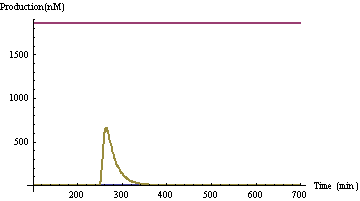
| CI: low state, CI434: high state, GFP: caused by food stimulus
|
| | Bell | 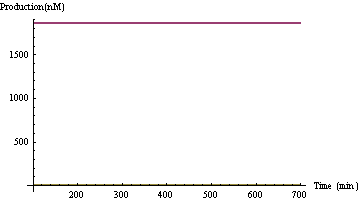
| CI: low state, CI434: high state, GFP: too small to see.
|
| | | 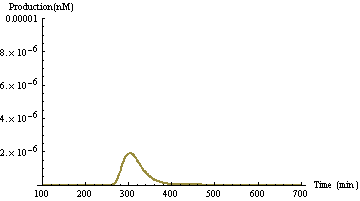
| The output of GFP is even lower here.
|
| | Food+Bell | 
| CI: from low state to high state, CI434: from high state to low state, GFP: two peaks
|
| With Memory | Food | 
| CI: high state, CI434: low state, GFP: caused by food stimulus
|
| | Bell | 
| CI: high state, CI434: low state, GFP: caused by memory and bell stimulus
|
| | Food+Bell | 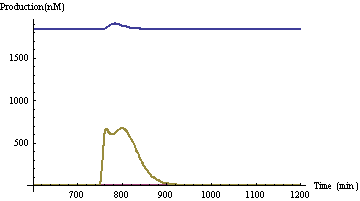
| CI: high state with a small peak, CI434: low state, GFP: two peaks
|
Then let's see how this model achieve the goal.
- Truth Table YES!
- Fit Dog's Reaction YES!
- VALUE NOT TOO EXTREME No. The value for AND Gate 2 is too extreme, which may cause difference between our model and actual process in cells.
Overall, this model is still able to perform well under all the circumstances, which means the P2 model is acceptable.
^Top
|